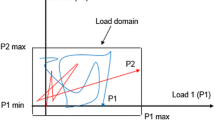Abstract
In this research, a suggested linear model was investigated to analyze the plastic stage for indeterminate skeletal steel structures. The aim of this model is to facilitate the analysis of the structure element in the plastic stage without resorting to the complicated calculations of the material nonlinearity. The suggested model was represented by considering the full plastic sections in the element as a concentrated plastic hinge. The plastic hinge was modeled instead of the plastic zones as a pin support or an intermediate hinge with a rotational spring. Computing the stiffness of rotational spring was based on the acceptance criteria in the nonlinear static analysis according to FEMA 356 (2000). The linear structural methods can be used after that to calculate the deformations and moments in plastic stage. In this paper and due to the simple cases which are analyzed, the forced method of structural analysis can be used. But for structural elements which are more complicated than the present cases where the plastic hinges are separated on more positions, the finite element analysis is the best. The suggested model can be used to predict the mechanism of failure, to evaluate the deformations after occurring the plastic moment as well as to compute the elastic redistribution moments. The suggested model was verified by comparing the experimentally and analytically results of steel beam deformations which made by El Damatty (J Steel Compos Struct 3:421–438, 2003) with the obtained results of the suggested model, and the suggested model gave good results. Moreover, a W-shaped fixed steel beam was analyzed by finite element method by using ANSYS program, the suggested model and elastic analysis to compute the induced moments in plastic stage and evaluated the elastic redistribution moments. The suggested model gave matching values of the induced moments of the fixed compared with the finite element results.




















Similar content being viewed by others
References
Federal Emergency Management Agency (FEMA 356) (2000)
El Damatty A, Abushagur M (2003) Experimental and analytical investigation of steel beams rehabilitated using GFRP sheets. J Steel Compos Struct 3:421–438
ANSYS® (2015) Academic Teaching Mechanical: ANSYS Help Documentation, Release 17.0, Canonsburg (PA), ANSYS, Inc
ABAQUS 2016 Theory Guide, © Dassault Systems, 2015
ADINA Theory and Modeling Guide, ADINA R & D, Inc. (2016) 71 Elton Avenue Watertown, MA 02472 USA, September 2016
Neal BG (1956) The plastic method of structural analysis. Chapman and Hall, London
Hodge PG (1959) Plastic analysis of structures. McGraw Hill, New York
Save M, Massonnet CH (1972) Calcul plastic des constructions (in French), vol 2. Nelissen, Belgique
Massonnet CH, Save M (1976) Calcul plastique des constructions (in French), Volume. Nelissen, Belgique
Nguyen-Dang H (1984) Sur la plasticité et le calcul des états limites par élément finis (in French). Special PhD thesis, University of Liege
Konig JA (1987) Shakedown of elastic–plastic structures. Elsevier, Amsterdam
Dentzig GB (1966) Application et prolongement de la programmation linéaire. Dunord, Paris
Bathe KJ (1996) Finite element procedures. Prentice-Hall, Englewood Cliffs, NJ
Bathe KJ (1982) Finite element procedures in engineering analysis. Prentice-Hall, Englewood Cliffs
Mamaghani IHP, Usami T, Mizuno E (2000) Inelastic large deflection analysis of structural steel members under cyclic loading. Eng Struct 18:659–668
Liew JYR, Chen H, Shanmugam NE, Chen WF (2000) Improved nonlinear plastic hinge analysis of space frame structures. Eng Struct 10:1328–1338
Hamidi SA, Danshjoo F (2010) Determination of impact factor for steel railway bridges considering simultaneous effects of vehicle speed and axle distance to span length ratio. Eng Struct 5:1369–1376
Muscat M, Mackenzie D, Hamilton R (2003) Evaluating shakedown under proportional loading by non-linear static analysis. Comput Struct 81:1727–1737
Jiang XM, Chen H, Liew JYR (2002) Spread-of-plasticity analysis of three dimensional steel frames. J Constr Steel Res 58:193–212
Kaliszky S, Logo J (1997) Optimal plastic limit and shake-down design of bar structures with constraints on plastic deformation. Eng Struct 19:19–27
Kaliszky S (1996) Elastoplastic analysis with limited plastic-deformations and displacements. Mech Struct Mach 24:39–50
Cocchetti G, Maier G (2003) Elastic–plastic and limit-state analyses of frames with softening plastic-hinge models by mathematical programming. Int J Solids Struct 40:7219–7244
Author information
Authors and Affiliations
Corresponding author
Rights and permissions
About this article
Cite this article
Farouk, M.A., Alzara, M. & Samir El-kady, M. Computing redistribution moments in the plastic stage by using linear analysis. Innov. Infrastruct. Solut. 3, 42 (2018). https://doi.org/10.1007/s41062-018-0143-6
Received:
Accepted:
Published:
DOI: https://doi.org/10.1007/s41062-018-0143-6




